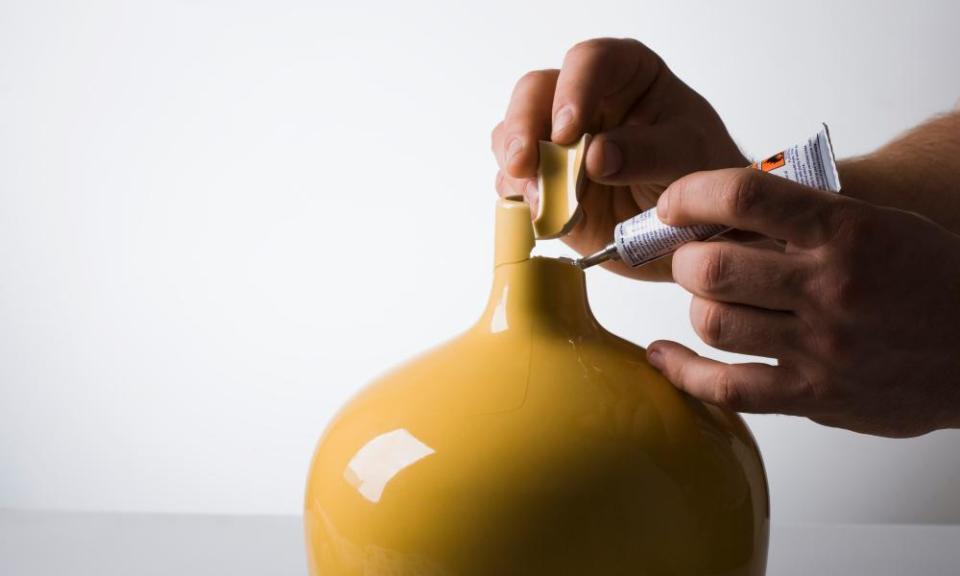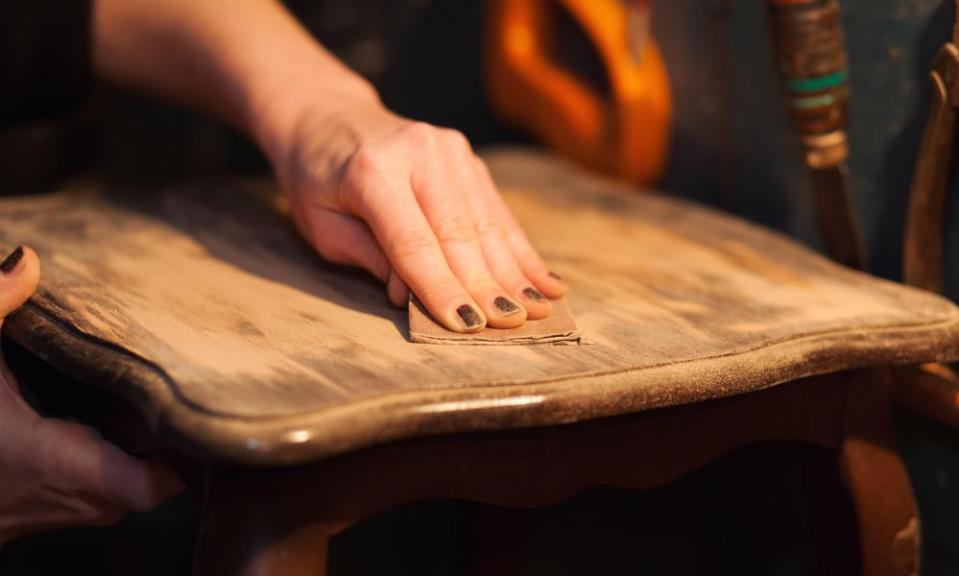From wonky tables to broken printers: how to solve the most irritating household problems

The lockdown is a good opportunity to learn to repair some commonly broken items. Not only do many of us have more time on our hands than usual, but shops are closed so we can’t easily replace items, and many expert restorers are shut, too. Prolonged proximity to your belongings, and a keener eye on your finances, may have given you a newfound appreciation for your stuff and the planet’s resources. These days you can find a wealth of fix-it tutorials online, but here’s where to start.
Fix a wonky table
Remove that bit of folded cardboard wedged under one leg. You may have a few things around the house that can stop a table wobbling so much, says Jay Blades, the antique furniture restorer and the presenter of the BBC’s The Repair Shop. One fix might be a few layers of felt “the same colour as the table. You could put that underneath to make it the correct height. Or you might have a cork coaster in your house – cut a bit to size and stick it underneath the bottom.”
Do up your doors

A squeaky door can be easily fixed with a bit of cooking oil, if you don’t have a lubricant such as WD40, says Blades. “Put it on your finger and work it into the hinge where it’s making the noise,” he says.
A door coming off its hinges needs to be screwed in again. “If the hole has become too big, push some matchsticks into the hole,” says Blades. “The ones that are sticking out, either break them off or use a little saw to make them flush. Then you can put the screw back in, and it will be tight. The matchsticks will act as a rawlplug. When I’m doing furniture, for little holes I put one in, but you might need four or five.”
Repair broken plates, mugs and vases
Cats “seem to be the number one culprits” when it comes to smashed pottery, says the ceramics conservator Kirsten Ramsay, who also appears on The Repair Shop. She advises against using items for their original purpose once repaired – a stuck-on handle may fail, which is not what you want when holding a mug of hot tea, and glued-together plates may leach chemicals into food, and will discolour. But they can be repurposed. A repaired vase can be used again, but with a cut-down plastic bottle or large yoghurt pot as a liner. And decorative items can be saved.
“Collect as much of it as you possibly can – I really mean every single tiny piece,” says Ramsay. “You need to identify what the material is. The two main materials are either porcelain, which is harder and glassier and has a translucency to it, and earthenware, which has a more open, crumbly texture and usually a glazed surface.”
Before sticking it, she says, “do a visual inspection and try and see how it goes together. Sometimes things slot together really nicely.” If they don’t, she thinks it’s probably best to leave it to a professional (if it’s a valuable or sentimental item).
“Work out what order the pieces go in so you don’t lock out a piece.” Ramsay uses acetone to clean and degrease the edges of the broken pieces. You can buy acetone online and in some chemists, but it can be dangerous (it’s flammable, an irritant and its fumes shouldn’t be inhaled) so it might be wise to skip this step. “If it’s a new break then it should already be clean and grease-free, so just use a soft, clean brush along the break edges to remove dust particles.”
Don’t use a generic superglue: “If you stick it in the wrong place, it can be difficult to get it apart and re-stick it.” Ramsay uses conservation-grade adhesives, which can be expensive and tricky for the average person to get hold of. For porcelain, an epoxy resin is suitable (a good hardware shop should be able to advise). She recommends HMG, a cellulose nitrate adhesive, for earthenware. Put a small amount of adhesive along one edge, put it in place, wipe off the excess and hold it together with small bits of clear tape.
Attend to sad seating
A ripped seat pad on a dining chair can be easily replaced, says Blades, who specialises in upcycling projects. “You could re-cover it with a tea towel – that looks quite pretty – or an old duvet cover. Cut out a square, put it over the old cover and staple it underneath. If you don’t have a staple gun, use a hammer and tacks.”
Fix your inkjet printer
“So much of repair,” says Janet Gunter, the outreach lead at the Restart Project, which teaches people how to repair electronics “is actually just cleaning, but cleaning in a very conscientious way.” This is especially true of inkjet printers. Even though she is not a fan of them – “they can be super-annoying” – don’t give up on one. Make sure the software is up to date. They need to be used every two weeks says Gunter, “and most people don’t know that. The print heads get clogged if they’re not used.”
She says you should print a few lines in black, and print colours, every couple of weeks to maintain it. “If the heads do get clogged, you’ve got a pretty big job to clean them, but it is possible.” Look online for tutorials. “We also see a lot of printers where there’s debris inside, or the rollers are dirty or something is jammed. You’ll need to partially disassemble it to clean it properly. It would help to have a torch or headlight. With disassembly, make sure you’re documenting as you go so you can put the thing back together again.”
And resurrect an old laptop
Many people are fishing out old laptops from cupboards now that working (and learning) from home has become commonplace, says Gunter. Older laptops have an advantage over modern, skinny ones in that they can be relatively easy upgraded. “It’s not that they’re broken, it’s a perceived obsolescence,” says Gunter. “With older laptops, the hard disk drives are going to slow down the machine.”
Replacing on of these with a solid state drive (SSD) is easier than you think, she says. “You can get them for about £20 or £30 and you can breathe new life into that old laptop. Many of the companies that sell them provide help in making sure you get the right one.”
You will need a very small screwdriver, “but you can get those shipped really easily with the replacement parts.” If you don’t need to get data off your old hard disk, it’s a fairly straightforward job, says Gunter (and there is lots of help online). “It’s just a matter of unscrewing the body, fitting the new drive in and then installing an operating system.”
You may also be able to upgrade the memory by ordering extra Ram. “It’s a little bit fiddly, but it’s not that difficult – people do it all the time at our events, and there are loads of YouTube videos online. Those two things together will breathe new life into almost any old machine. It feels like you’re saving something from the shredder – it’s really rewarding.”
Restore a wooden worktop or table

You need sandpaper, says Blades, “and a lot of elbow grease. Sanding will get rid of knife marks and stains, but you’ll have to do a lot of it. Start with coarse sandpaper and work your way up to a finer one. Do enough until it looks even throughout, then reapply wax or oil.” He recommends using a hard wax, “one that’s safe for kitchens. It’s very easy then to buff it up afterwards.”
Sort out stains

Lots of marks on carpets and upholstery can be removed with warm water, says the TV cleaning expert Aggie MacKenzie, who runs AggiesTips.com. “If that doesn’t work, try a carpet cleaner or even just a squirt of washing-up liquid, but very dilute in warm water,” she says. Swish your hand around in the water until you get the foam at the top, “and then use that foam to clean the carpet. Don’t drench the carpet in soap because it’s hell to get out, and it’s just boring.” Work from the outside of the stain in, “so you’re not spreading the stain. Don’t rub too hard because you might damage the pile and it might look too different from the rest of the carpet.”
Remove marks from walls
Scuff marks can gather near the front door, or on the walls by the stairs. “Teenagers always seem to stand next to a wall and stick one foot up on the wall,” says MacKenzie. “It’s really weird and very annoying.” She recommends a “magic eraser”, made by several brands. “You wet the sponge, squeeze it out and gently take it over the marks. It’s very abrasive, so you have to be gentle, but it’s brilliant at removing those stains from walls, and also from lino on floors.” Weirdly, she adds, a bit of stale bread may also work.
For a grease mark on walls, “place clean kitchen paper over the stain and press with a warm dry iron to draw out the oil. If any remains, dust the area with talc or cornflour and brush off with a soft brush.” To remove hardened Blu Tack without taking the wallpaper or paint with it, “hold a plastic bottle filled with warm water over the area – it will become soft again. Now use a fresh piece of Blu Tack against the old, dabbing gently.”

